Dickson Falls is a stunning 25-foot waterfall nestled in Fundy National Park. It’s one of the most popular destinations in the park and for good reason!
The 1.5-kilometer hike to the waterfall begins with a lookout onto the Bay of Fundy where you can watch the Atlantic Ocean crash against rugged cliffs. The trail then travels through the Wabanaki/Acadian forest and down into a lush river valley. On a hot summer day, the air cools as you descend to Dickson Brook. At the bottom, spruce and birch trees tower high above, while mossy rock faces and lush ferns complement the green canopy.
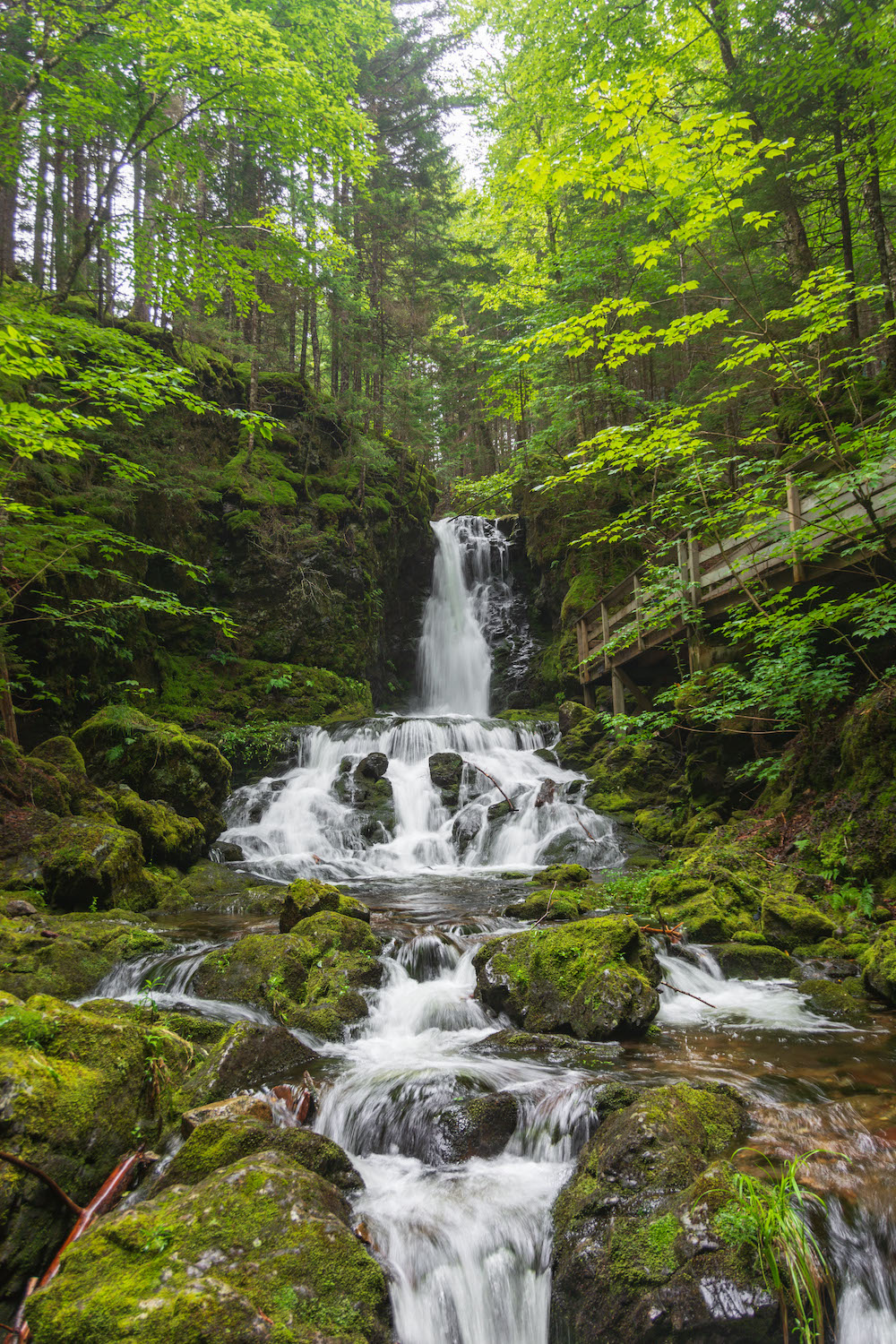

The brook meanders forming slender ribbons of water that meet on occasion to form a powerful current. As you near the waterfall, the low roaring of water grows louder and a hazy mist is kicked up by the falls. It’s quite awe-inspiring.
If you’re ever on the Fundy Coast, definitely put this waterfall on your bucket list! Below is my guide for visiting Dickson Falls. It includes directions, trail conditions, and information about the surrounding ecosystem.
Getting There
Dickson Falls Trail, Alma Parish, NB
Dickson Falls is located in Alma Parish off Point Wolfe Road. To access the trail, you need to purchase a day pass from Fundy National Park. You can do this at the park entrance or the visitor centre.
Dickson Falls Trail
Dickson Falls Trail is a short and easy 30-minute loop. It’s made up of compact soil, crushed rock, boardwalks, and stairs. There are picnic tables and a pit toilet at the trailhead. Rest benches are located throughout the trail.
Visitors must stick to the trail and boardwalks to protect the surrounding ecosystem. Swimming and wading are not permitted. Leashed dogs are welcome.
Hike the trail clockwise to get the best views of the brook and waterfall.
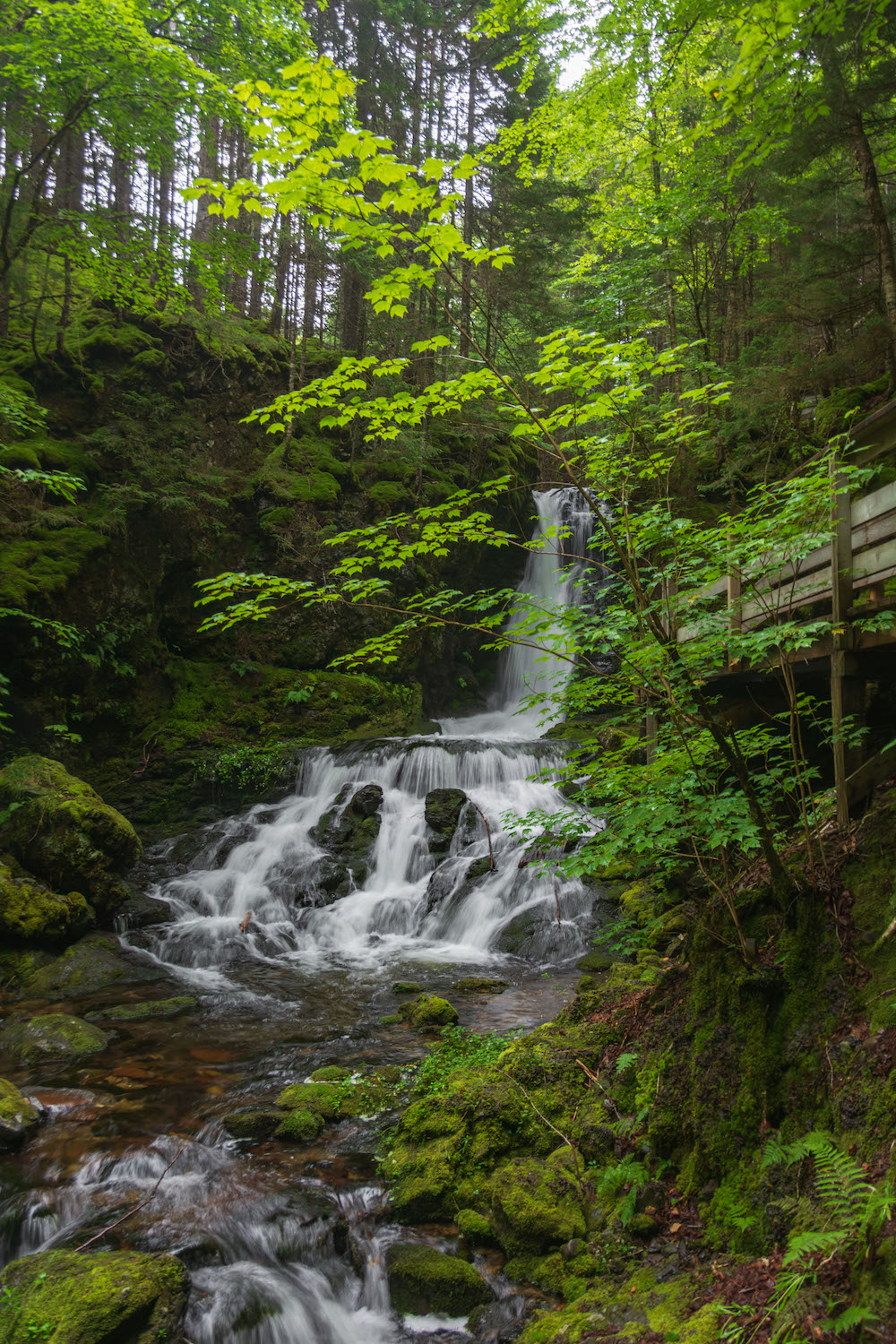
When to Visit
Spring through fall is the best time to visit Dickson Falls. The waterfall flows most strongly in the spring, while autumn boasts vibrant colours. If you’re looking for some tranquility, hit the trail early morning or just before sunset. Peak daytime hours are often crowded and the parking lot fills quickly.
AllTrails mentions that the road to Dickson Falls is closed during winter, but the trail is still accessible by hiking an extra 2 kilometres. Depending on the conditions, you may need snowshoes or ice cleats to hike safely.
The Ecosystem
You’ll encounter two distinct habitats on Dickson Falls Trail. The first is a dry, primarily coniferous forest. The other is a cool and wet valley. Interpretative signs teach you about the flora and fauna found within each and challenge you to spot different species. Here’s a little more about the maple and bird species you encounter on the trail:
Maples
Dickson Falls Trail is home to three species of maple tree: red maple, striped maple, and mountain maple. Maples are famous for their beautiful autumn colours. Mid-September to early-October, you can catch hues of red and yellow throughout the trail.
Red maples grow as tall canopy trees, while striped and mountain maples are understory shrubs. All of them have palmate leaves that are arranged opposite on stems.
Maples provide food and habitat for mammals, birds, and insects. Nectar and pollen from spring flowers are a favourite of bees. The fruit, known as samaras, are consumed by birds, squirrels, and chipmunks. Deer, porcupine, and moose eat the twigs and leaves.
Red Maple (Acer rubrum)
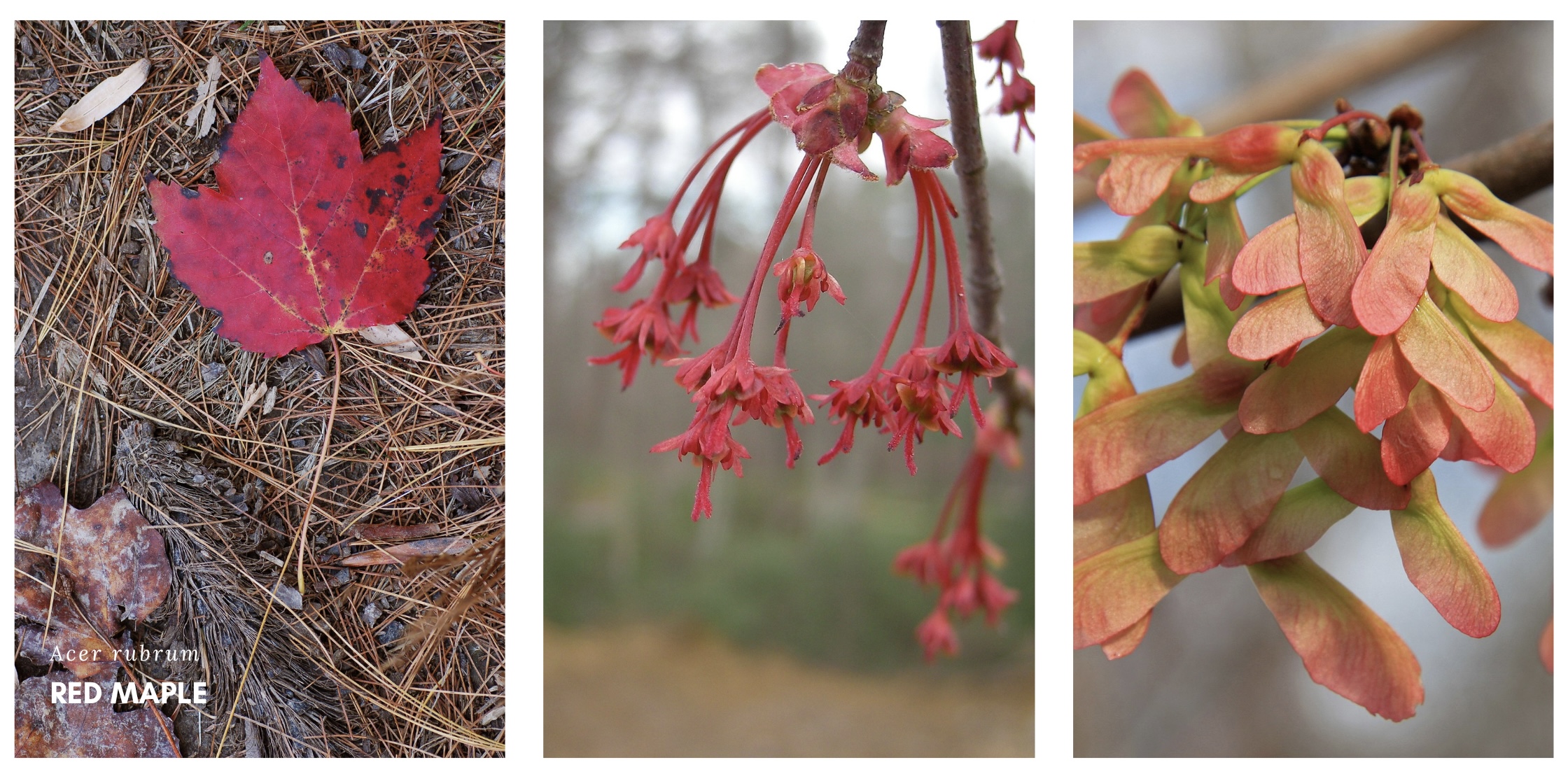
As their name suggests, red maples have vibrant red foliage in the fall. Their twigs, buds, and flowers are also red. They bloom in early spring and can grow 120 feet tall. Red maples can tolerate a wide variety of soil conditions, which is why they’re so widespread in the Acadian/Wabanaki forest.
Striped Maple (Acer pensylvanicum)
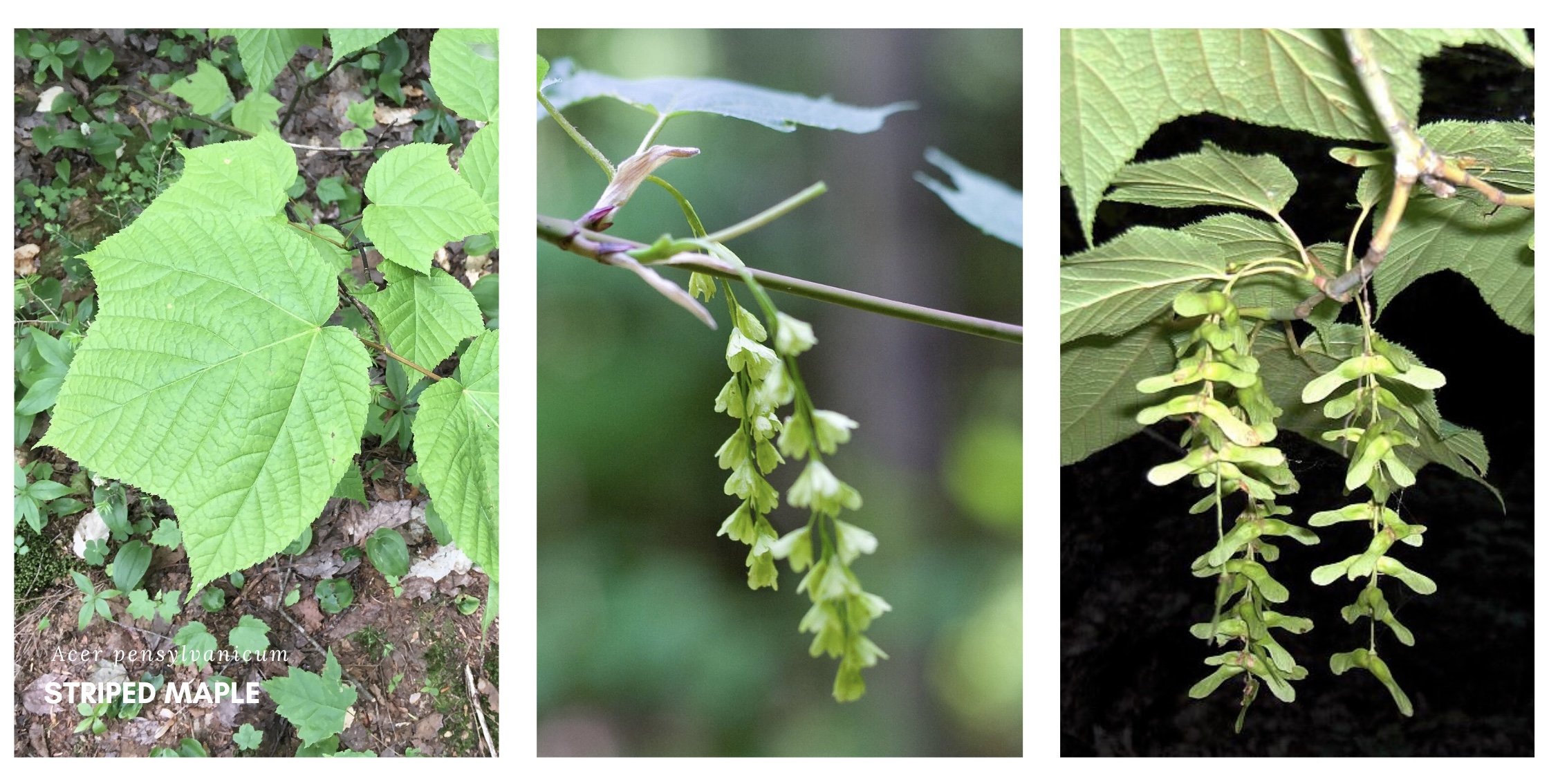
Striped maples thrive in cool and moist forests. They are shade tolerant and often shadowed by larger canopy trees. Their maximum height is around 33 feet.
These understory trees create important habitat for many animals – including birds. Striped maples become a beautiful golden yellow in autumn and bloom in late spring. Their flowers are bell shaped and hang in delicate clusters.
Mountain Maple (Acer spicatum)
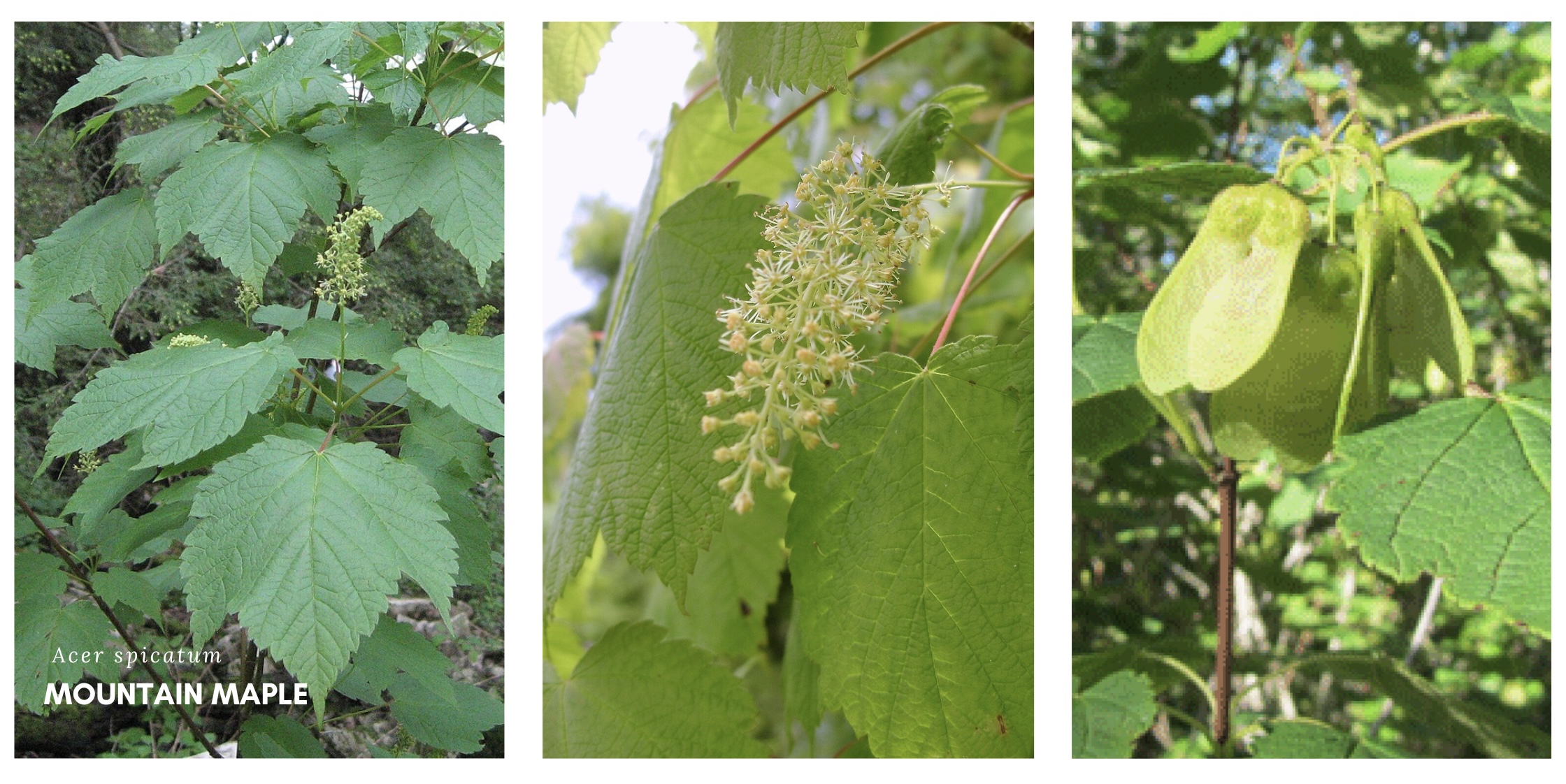
The shortest of these three maple species is the mountain maple. It grows to a maximum height of 25 feet. You’ll find it in wet forests on well drained rocky slopes and around streams. In autumn, their leaves turn a bright yellow or muddy brown. In spring, they send out yellow flowers on long spikes.
Birds
There are 55 recorded bird species on eBird for Dickson Falls Trail. Top sightings include the cedar waxwing, pine Siskin, and boreal chickadee. An interpretive sign on the trail uses mnemonics to teach you the songs of the olive-sided flycatcher, white throated sparrow, and Eastern wood pewee.
Generally, birds are most active from dawn to 11am. Hit the trail early to avoid crowds that may scare them away or drown out their songs. The Merlin Bird ID app is a useful tool for learning about birds and their calls.
Olive-Sided Flycatcher (Contopus cooperi)

The olive-sided flycatcher makes its way into Canada around April/June for its breeding season. You can hear the males singing their breeding song in the canopy at Dickson Falls. The song has been described as “quick, three, beer.” Olive-sided flycatchers also make a short and successive “pip” sound to call to one another.
Flycatchers are masters at swooping through the air and catching insects. Sadly, Canada’s Species at Risk Act (SRA) recognizes the olive-sided flycatcher as a threatened species.
White Throated Sparrow (Zonotrichia albicollis)

Also arriving in Canada in April/June, the white throated sparrow’s song sounds like, “O-oh sweet Canada, Canada, Canada.” These sparrows travel in loose flocks and nest on or near the ground in shrubs.
White throated sparrows have two distinct colour markings. Some have two white stripes on their head, while others have tan stripes. Male white striped birds have higher testosterone levels and are more aggressive than their tan counterparts. They sing more often, the primary way they defend their territory, and are more likely to chase off birds when singing fails. In contrast, tan striped birds are more nurturing and bring their young more food.
Eastern Wood Pewee (Contopus virens)

The Eastern wood pewee arrives in Canada in May. If you can remember its name, the song is easy to recognize, it sounds like “pee-a-wee.”
The eastern wood pewee uses maples as nesting trees. It carefully constructs an open cup nest from strips of bark, twigs, mosses, roots, leaves, lichens, and pine needles. To make sure the nest stays on the tree, it uses spider webs to affix it!
Things to Do Nearby
To make the most out of your trip, check out some of the following locations! They’re all within a 5 minute drive from Dickson Falls.
MacLaren Pond Medicine Trail: The MacLaren Pond Medicine Trail was developed by Fort Folly First Nation. It teaches visitors about the medicinal, spiritual and traditional uses of native plants. It’s a brief one kilometre walk with interpretative signs.
Kelly’s Bake Shop: Kelly’s Bake Shop is good…too good! They’re known for their sticky buns, but equally delicious are their donuts, peanut butter cookies, and baked bread.
Fundy Take-Out: Fundy Take-Out is a small seafood restaurant with outdoor seating. Their fish and chips are delicious! Grab a picnic table and enjoy your food with views of Upper Salmon River.
The Captain Molly Kool Heritage Centre: The Molly Kool Heritage Centre celebrates Canada’s first female sea captain and the second female sea captain in the world! The Heritage Centre is a recreation of Molly’s childhood home.
Happy Hiking!
I hope this post inspires you to visit Dickson Falls Trail. Whether you are seeking a picturesque landscape or want to learn more about the Acadian Forest and some of its inhabitants, this is a great place to do it!
Other Posts You May Enjoy
Acadian Forest: History, Species, and Biodiversity
Backcountry Camping in Kouchibouguac National Park
Tracey Lake Camping, Fundy National Park
Third Vault Falls, Fundy National Park
Sources
Nancy J. Turner. 2019. Maple Trees in Canada. The Canadian Encyclopedia.
CBC News. 2010. Molly Kool’s Childhood Home Being Rebuilt.
Jenny McKee. 2022. 10 Fun Facts About the White-throated Sparrow. Audubon.
Georgian Bay Biosphere. Eastern Wood-Pewee.
The National Wildlife Federation. Red Maple.
Kenn Kaufman. 2017. The Fascinating and Complicated Sex Lives of White-Throated Sparrows. Audubon.
Kenn Kaufman. Eastern Wood Pewee. Audubon.
Image Credits
Acer rubrum leaf: Photo (c)2007 Derek Ramsey (Ram-Man), GFDL 1.2, via Wikimedia Commons
Acer rubrum flowers: Danny S., CC BY-SA 3.0, via Wikimedia Commons
Acer rubrum seeds: Dcrjsr, CC BY 3.0, via Wikimedia Commons
Acer pensylvanicum leaf: English: NPS, Public domain, via Wikimedia Commons
Acer pensylvanicum flowers: paul_houle, CC BY-SA 2.0, via Wikimedia Commons
Acer pensylvanicum seeds: Homer Edward Price, CC BY 2.0, via Wikimedia Commons
Acer spicatum leaf: Mason Brock (Masebrock), Public domain, via Wikimedia Commons
Acer spicatum flowers: Mason Brock (Masebrock), Public domain, via Wikimedia Commons
Acer spicatum seeds: Homer Edward Price, CC BY 2.0, via Wikimedia Commons
Contopus cooperi: Andy Reago & Chrissy McClarren, CC BY 2.0, via Wikimedia Commons
Zonotrichia albicollis: Cephas, CC BY-SA 3.0, via Wikimedia Commons
Contopus virens: Rhododendrites, CC BY-SA 4.0, via Wikimedia Commons
All uncredited images are my own and cannot be remixed, shared, or distributed without permission.